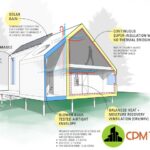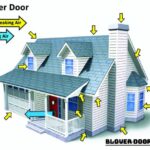Passive house
Energy efficient house for greener living: Passive house principles
Passive house scheme
• Compactness: Passive houses are designed to be as compact as geometrically possible in order to reduce the external area of the building per room or floor area. A cube-shaped building is ideal
• Super insulation: the thick insulation layer characteristic of passive houses significantly reduces the heat flux through the walls, roof and floor and thus also the U-value of the barriers.
• Location and size of openings: in passive houses, the main windows are placed to the south, the sun must shine from the south windows in winter, but this is not recommended in summer, so shading the windows is very important. East and west windows can easily cause high temperatures in the room, so it is very important to simulate them first.
• High-quality windows and their installation: windows are like holes in the insulation of a building, so they need to be given a lot of attention. To achieve a sufficient level, very good quality windows must be used and they must also be installed correctly with an insulation overlay.
• Heat recovery ventilation: the heat of the air leaving the building is used to heat the air supplied to the room, so no energy is lost.
• Cold bridge-free construction: Cold bridges must be so small that the internal surfaces of the building are homogeneous in temperature.
• Airtightness of the building box: the passive house must be airtight, this is achieved by a single continuous airtight layer and by taping the joints of the materials.
Passive house criterion:
• The heat demand of the building (calculated with the passive house design package PHPP) does not exceed 15 kWh / (m2 a).
• The total primary energy demand, including all energy costs incurred in the house (space heating, hot water and electricity), does not exceed 120 kWh / (m2 a).
• The result of measuring the airtightness of the building (air exchange in multiples at a pressure difference of 50 Pa) n50 must not exceed 0.6 1 / h.
• The passive house standard does not prescribe with which materials the required result must be achieved. It is important that, in the end, the building functions in accordance with these parameters.
How to achieve this?
The heat load of 10 W / m2 is extremely low. How is it still possible to keep the house warm even on the coldest winter days? It is important to follow two clear principles:
• reduce heat loss
• optimize the passive use of solar energy
Without using both principles together, it is not possible to achieve the level of a passive house. The most important thing is to reduce heat losses.
If you put the emphasis on passive energy use in a poorly insulated house, the joy will always be short-lived – the actual net heat production (available heat minus losses) is limited to short transition periods, where the heating demand of the house is low anyway. If the insulation is made mediocre, in a beautiful clear winter weather, a situation arises where a room with a large south-facing window becomes warm – but in the evening it is cold again, because the heat is not retained in the room. Only very good insulation actually benefits from passive solar energy.
If the insulation has been brought to such a good level that solar radiation has a significant effect on keeping the house warm already in December and January, we can start talking about a passive house standard solution.
In the case of heat losses, a distinction is made between:
• disappeared through the airtight barrier by heat transfer (transmission losses), and
• disappeared through airflow (ie ventilation and infiltration).
To get a passive house standard house, both of them have to be significantly reduced compared to the usual one. Only then can winter sunlight cover these losses. Techniques to look out for are 5:
• thermal insulation of the wall, roof, floor
• reduction of cold bridges
• making the house box airtight
• use of passive house windows
• Use of high-efficiency heat recovery equipment in the ventilation system
It may seem quite surprising that following these five points is already sufficient for the passive house standard. All of these are more or less common techniques for limiting energy costs. Something fundamentally new – a different construction or device – is not implemented in the passive house concept, the parameters of all these parts are simply improved. But this is remarkable! How these components work together plays a major role. Therefore, a passive house presupposes so-called integrated planning, where the role of each part in the formation of the final result can be accurately monitored with the help of the respective software.
What are the requirements for architecture? In most cases, no more than that, the overall concept of the house is clearly expressed in all phases of planning. There are clear goals that need to be met. Form and openings are just one tool. Disadvantages can be compensated by others. Therefore, passive houses do not look special today. The quality of windows has increased so significantly that the passive house standard is already achieved with completely ordinary opening solutions. Nor do they necessarily have to be perfectly south-facing. The variety of possibilities allows each project to be approached completely individually.





